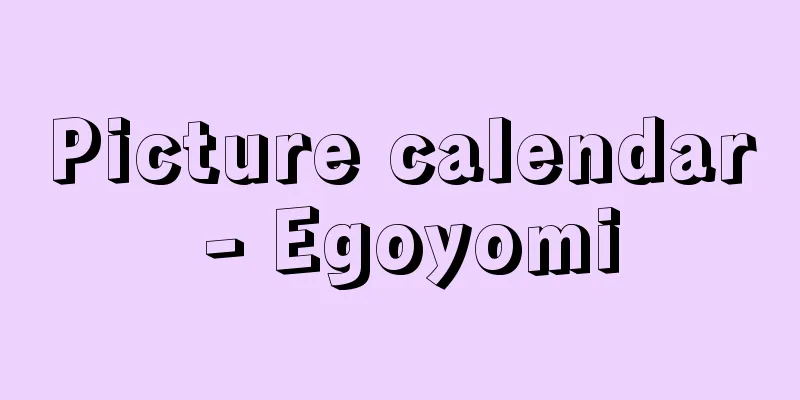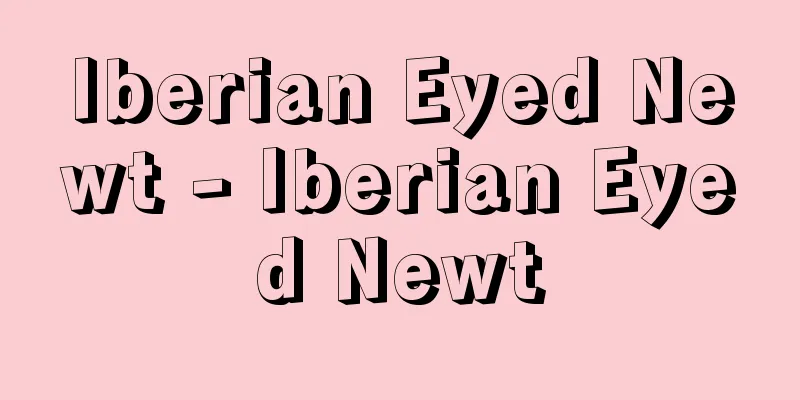Picture calendar - Egoyomi

|
A calendar that uses pictures to explain things without using text. It is a single-page print made for people who cannot read, and this type of picture calendar was found all over the country during the Edo period. A full-scale picture calendar that uses riddle pictures to show the calendar days needed for farming, sericulture, etc. can be found in the Iwate Prefecture region of the former Nanbu domain, and is called the "Nambu Blind Calendar." It is also called the Zatō (blind person) calendar. For example, the numbers on a dice indicate each month, and the animals of the Chinese zodiac are drawn on them to indicate which day the first day of that month falls on. The long months are represented by large swords and the short months by small swords. In addition, a picture of a thief carrying a load indicates the beginning of the rainy season (stealing loads), and a row of bowls, stacked boxes, and arrows indicates the 88th night, and the voiced consonant mark is added to the word poppy to read the summer solstice. This illustrated calendar is said to have started before the Tenmei era (1781-1789) in the Edo period, and the first document to introduce it was in the Kansei era (1789-1801) edition of "Touyuki" (Travelogue of the East) by Tachibana Nankei. The prototype of the current calendar is the Morioka type, which was created in the early Bunka period (1804-1818) and was popular within the domain, mainly around Morioka Castle. Publication ceased during the Meiji period, but it was republished and has continued to exist since then. It is used as a practical calendar in the northern part of the prefecture and the Sanriku region, and is highly valued as a folk material. [Ryosuke Saito] Source: Shogakukan Encyclopedia Nipponica About Encyclopedia Nipponica Information | Legend |
|
文字を用いず絵で解説してある暦。文字を解さない人たちのためにつくられた一枚摺(ず)りのもので、江戸時代には各地にこの種の絵暦があった。判じ絵で農耕・養蚕などに必要な暦日を示した本格的な絵入り暦は、旧南部藩領の岩手県地方にみられ、「南部めくら暦」という。座頭(ざとう)(盲人)暦ともよばれる。 たとえば賽(さい)の目で、それぞれの月を示し、それに十二支の動物を描いているのは、その月の朔日(ついたち)はなんの日ということをさしている。大の月は大刀、小の月は小刀で表しているほか、盗賊が荷を担いでいる図で「入梅(にゅうばい)」(荷奪い)を示していたり、鉢、重箱、矢を並べて「八十八夜」、罌粟(けし)に濁音符を加えて「夏至(げし)」と読ませているなど、判じ絵的な特色がある。この絵暦は、江戸時代天明(てんめい)(1781~1789)以前に始まったとされ、寛政(かんせい)(1789~1801)版の『東遊記(とうゆうき)』(橘南谿(たちばななんけい))に紹介されたのが最初の文献という。現在のものの原型は、文化(ぶんか)(1804~1818)初期にできた盛岡系で盛岡城下を中心に藩内に普及。明治期版行が中絶されたが、復刊されて以後も存続、県北、三陸地帯では実用暦に用いられ、民俗資料として貴重視される。 [斎藤良輔] 出典 小学館 日本大百科全書(ニッポニカ)日本大百科全書(ニッポニカ)について 情報 | 凡例 |
>>: Perilla frutescens var. japonica
Recommend
Enrikatsujutsu - Enrikatsujutsu
…In order to simplify the calculation of length a...
Emperor Gosanjo
Year of death: May 7, 5th Enkyu (June 15, 1073) Ye...
Uchida [town] - Uchita
A former town in the Naka district in northern Wak...
Lake Kasumigaura
A lake in southern Ibaraki Prefecture. Also called...
National Museum of Science and Technology
…The Society's main facilities are located in...
Krebs
German-born British biochemist. He studied at the...
Flower ceremony - Kasiki
A formula expressing the structure of a flower. F...
Ireland, D.
…The Australian representatives of the countercul...
blaze
...Figure 2 is a typical example, where most of t...
Japan Trench
A trench east of Honshu. In the north, it borders ...
Raw Silk Inspection Station
A national inspection agency that inspects the qu...
Leg whiskers - customer
…The terminal segment is a movable finger that in...
People's China (English spelling)
A Japanese-language monthly magazine published in ...
Tomie [town] - Tomie
An old town occupying the southern part of Fukue I...
Maitreya Sutra - Mirokukyo
A general term for the sutras that describe the fu...









